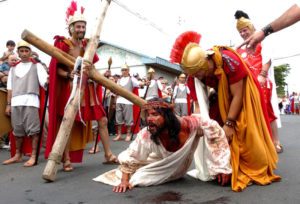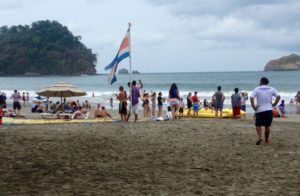
Like most of Latin America, Costa Rica is predominantly a Roman Catholic country. One major festivity in the calendar is Semana Santa (Holy Week). It honors the passing and resurrection of Jesus Christ. This year, Holy Week begins on Sunday, March 25 and ends on Saturday, March 31.
Holy Week For the Christian believers who observe it, each day of the Week has a especial meaning.
* Palm Sunday marks the beginning of this religious celebration. According to history, Domingo De Ramos conmemorates the day Jesus Christ enters Jerusalem on a donkey and is received in triumph by crowds, that waving palm branches, acclaimed him as the Messiah.
* During the next three days (Monday to Wednesday) churches hold daily services as preparation for the last three days of the Week, or Triduum, which are considered the most important.
* Holy or Maundy Thursday is remembered as the day of the Lord’s Supper, when Jesus told his disciples “that you love one another, as I have loved you, that you also love one another.” It is also the day Jesus was arrested in Gethsemane.

The most well-known day of Semana Santa, Good Friday, is a day of mourning and penance. It marks the day Jesus died on the cross. The services are focused on his last words, known as Seven Last Words from the Cross. These sayings are thought to mean:
1.Forgiveness,
- Salvation,
- Relationship,
- Abandonment,
- Distress,
- Triumph.
- Reunion.
* Holy Saturday, or Easter Eve commemorates the day Jesus’ body rested in Joseph’s crypt and the Harrowing of Hell, which represents the victory of Christ over all his enemies. There is also a Vigil and a candlelit procession in preparation for the Resurrection on Sunday.
* Easter Sunday (Domingo De Resurrection) celebrates the triumphant resurrection of Jesus Christ and marks the end of Semana Santa.
Tico Traditions
* In many places in the country there are full-dress reenactments of the Passion, which represent Jesus Christ’s journey to the cross. Some participants dress up as Roman soldiers and others as Jesus’ followers. The most famous Holy Week processions take place in San José, Heredia, and San Rafael de Oreamuno. There are also religious parades and concerts.
* In San Francisco, a village in Province of Heredia, tradition has it that for a whole year, the inhabitants take care of a “special” donkey, that represents the one Jesus rode on in Jerusalem. During Palm Sunday, the donkey, carrying an effigy of Jesus Christ, takes part in processions in the Province.
* Believers usually keep the blessed palm leaves they receive during Domingo de Ramos Some weave them in the form of a cross and hang them behind their houses’ doors as protection against evil.
* For many ticos, Semana Santa is a time to get together and prepare traditional meals. Some season favorites are rice and shrimp, ceviche, cod soup and fried fish.
* Semana Santa is not a good time for meat lovers though. Most restaurants serve fish-based dishes during this time.
* Desserts are also part of the menu. Chiverre, a large round fruit similar to a squash, is the basic staple for “conserva” or “miel de chiverre”. After a somewhat laborious cooking process, the fruit turns into a preserve and it is consumed cold, or as a filling of empanadas and other desserts.

Things to Bear in Mind in Semana Santa
* This year’s Holy Week is unlike any other as it includes a presidential election. On April 1, a run-off vote will be held to decide who, between Carlos Alvarado and Fabricio Alvarado, the next president is going to be.
* Banks, schools, government, professional offices and other businesses will be closed on the official holidays, Maundy Thursday and Good Friday. Some of them will be closed for the entire week.
* Semana Santa is a religious holiday and at the same time it is high season for vacationists, tourists and travellers. It is likely that there will be a higher volume of traffic on the roads going out of the cities, as many people take off time from work and head out for their preferred getaway spots all over the country.
* As a result while cities become peaceful and quiet, beaches, mountains and other popular holiday places get totally crowded.
* if you choose to leave the city, brace yourself for the heavy traffic on the return trip.
* Buses and other public transport services become few and far between during those days.
* Along with Christmas, Easter is peak vacation season, so most accommodations, bus and plane tickets are scarce and everything is very expensive.

* In some municipalities, but not in all, there will be “Dry Law” or Ley Seca, especially on Thursday and Friday. Dry Law means that many supermarkets, pulperias, liquor stores, bars, restaurants and other business can not sell liquor, beer or wine.
* in spite of Dry Law, many people stock up on liquor well before it begins and take advantage of the holidays to drink and party.
In general, during Holy Week the whole country slows down to a crawl. It is a good idea to plan your activities well in advance.
Holy Week is a solemn time of worship and reflection, a time of spiritual renewal. It is also a time for enjoying the country’s beautiful landscapes. If you have never lived the Catholic faith from this perspective, maybe you can combine a day at the beach with a procession – there are many of them in most of the cantons of the country – and later enjoy a cod soup, pastel de palmitos (palm hearts) y atún – a pie filled with tuna, palmito, eggs and spices and for dessert empanadas de chiverre and coffee. All is possible in Costa Rica.
